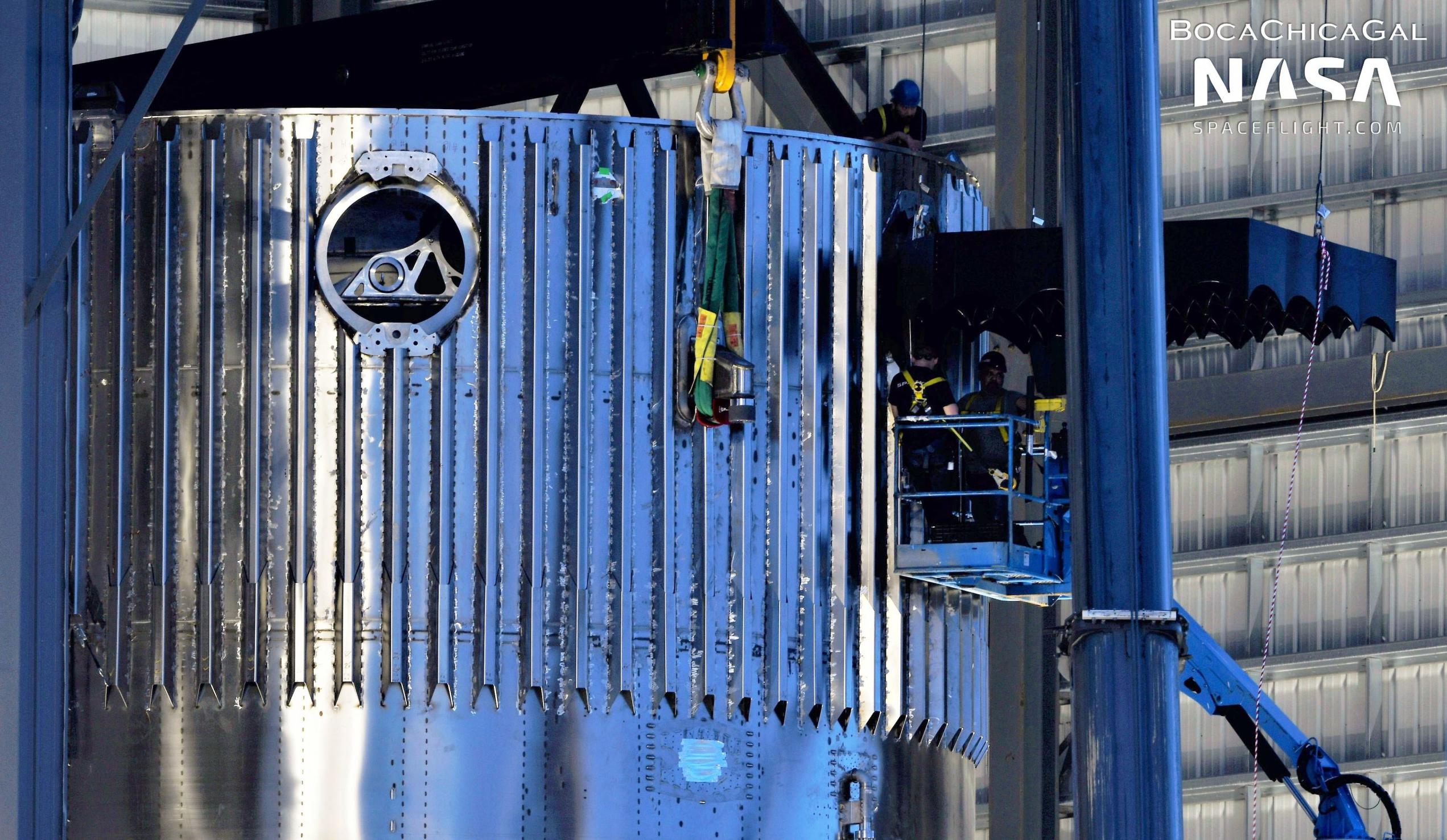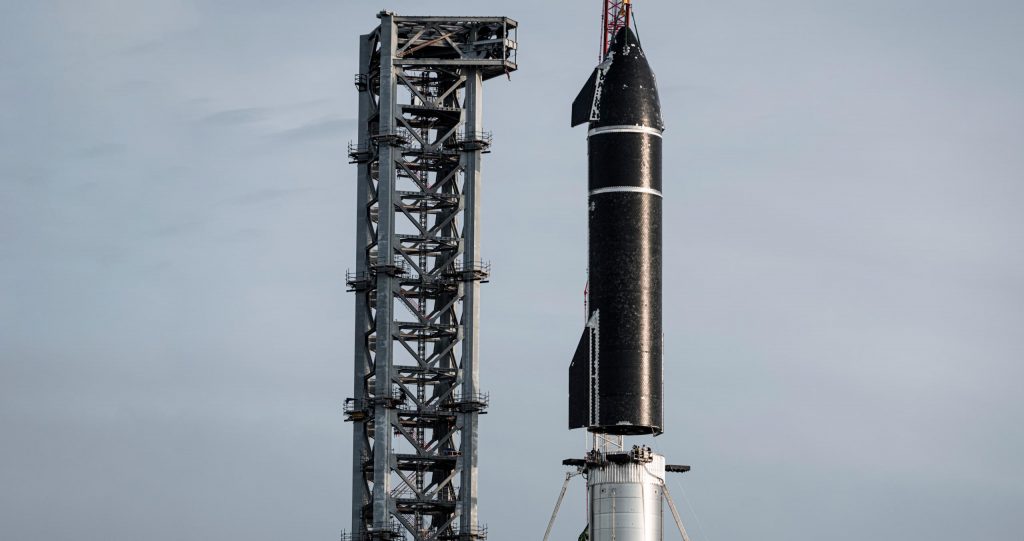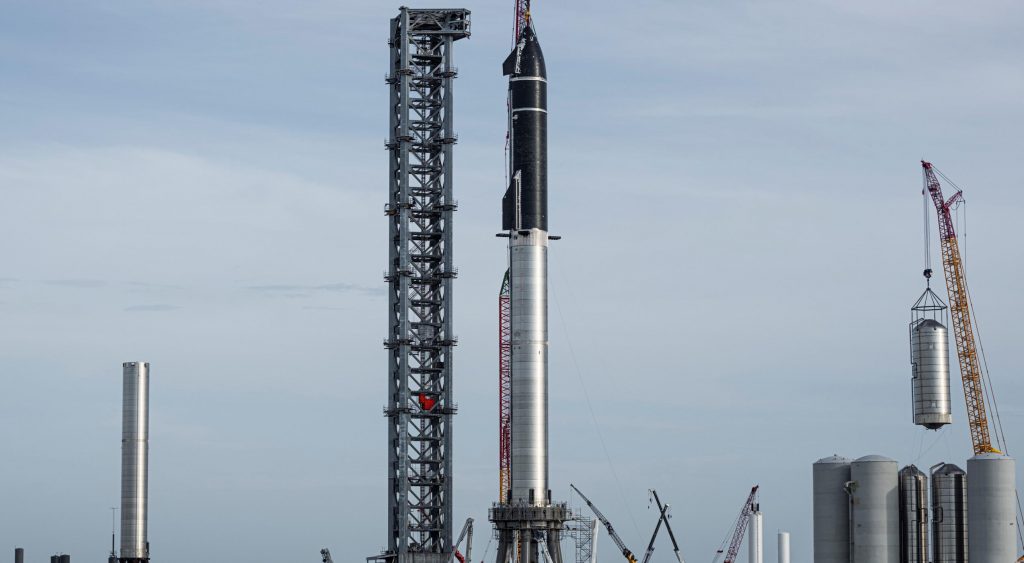

News
SpaceX installs full set of car-sized grid fins on second Super Heavy booster
SpaceX appears to have installed a full set of car-sized grid fins on Starship’s second flightworthy Super Heavy booster, leaving the massive rocket just a few steps away from completion.
Measuring ~69m (~225 ft) tall and 9m (~30 ft) wide, Super Heavy Booster 5 (B5) – like B4 before it – will be one of two of the largest rocket boosters ever built once completed. In broad strokes, Super Heavy B4 and B5 are the same. Aside from near-identical dimensions, both have been built to hold up to 29 Raptor engines while Starbase has already begun receiving parts of the first 33-engine Super Heavy. That means that Booster 4 and 5 – while both potentially capable of flight – are also pathfinders for an upgraded version of Super Heavy with similar dimensions but the potential to produce more than 40% more thrust once Raptor 2 production takes over.
While more similar than not, there are significant differences between SpaceX’s first and second flightworthy Super Heavy boosters.
The biggest visible differences are tweaks SpaceX has made to the Super Heavy assembly process. Booster 4 was assembled out of mostly naked steel rings and only had thousands of feet of external plumbing, wiring, raceways, and hardware installed after it was stacked to its full height. That may partially be because CEO Elon Musk had ordered SpaceX to complete the first full-height Starship stack by early August, requiring the build team to prioritize speed above all else.
Regardless, SpaceX appears to be outfitting Super Heavy Booster 5’s exterior before and during the process of stacking the booster to its final height. Most sections of 3-4 steel rings have had partial plumbing and raceways preinstalled, meaning that Booster 5 will be far closer to test readiness than Booster 4 once stacking is complete. Booster 4, on the other hand, required at least several more weeks of outfitting after SpaceX briefly rolled the rocket to the orbital launch pad for a full-stack photo-op and fit check.


On October 12th, after rapidly stacking Super Heavy B5’s upper methane tank to completion, SpaceX began installing the booster’s four car-sized grid fins. Fixed in place and assembled out of welded steel unlike the Falcon family’s deployable, cast titanium fins, Super Heavy grid fins are several times larger and heavier but still serve the same purpose of stabilizing boosters during atmospheric reentry, descent, and landing. Like Booster 4, SpaceX has also installed all four Booster 5 grid fins before stacking the Super Heavy to its full 69-meter height.
Based on B4, that final stack could happen just a few days from now, though there are signs that it might take B5 a fair bit longer. Notably, whereas Booster 4’s aft liquid oxygen (LOx) tank was already fully stacked by the start of grid fin installation, Booster 5’s LOx section is still waiting on its thrust dome. That thrust section was most recently spotted inside a production tent on October 11th – far more thoroughly outfitted than Booster 4’s aft but awaiting installation nonetheless.
That slight difference in timing pales in comparison to a massive tube that may or may not have been installed inside Super Heavy B5 late last month and that definitely wasn’t installed in B4. Without official information, it’s hard to know for sure, but the general community consensus is that this new tube (possibly one of two installed inside Booster 5’s LOx tank) is some kind of header tank or sump meant to collect propellant for Super Heavy’s boostback and/or landing burn.
If SpaceX really is adding header tanks to Super Heavy, it would drastically increase the complexity of booster plumbing, potentially explaining why Super Heavy B5’s thrust section installation is taking longer than B4. Only time (and hopefully a tweet or two from Musk) will tell.
Elon Musk
Tesla reveals it is using AI to make factories more sustainable: here’s how
Tesla is using AI in its Gigafactory Nevada factory to improve HVAC efficiency.

Tesla has revealed in its Extended Impact Report for 2024 that it is using Artificial Intelligence (AI) to enable its factories to be more sustainable. One example it used was its achievement of managing “the majority of the HVAC infrastructure at Gigafactory Nevada is now AI-controlled” last year.
In a commitment to becoming more efficient and making its production as eco-friendly as possible, Tesla has been working for years to find solutions to reduce energy consumption in its factories.
For example, in 2023, Tesla implemented optimization controls in the plastics and paint shops located at Gigafactory Texas, which increased the efficiency of natural gas consumption. Tesla plans to phase out natural gas use across its factories eventually, but for now, it prioritizes work to reduce emissions from that energy source specifically.
It also uses Hygrometric Control Logic for Air Handling Units at Giafactory Berlin, resulting in 17,000 MWh in energy savings each year. At Gigafactory Nevada, Tesla saves 9.5 GWh of energy through the use of N-Methylpyrrolidone refineries when extracting critical raw material.
Perhaps the most interesting way Tesla is conserving energy is through the use of AI at Gigafactory Nevada, as it describes its use of AI to reduce energy demand:
“In 2023, AI Control for HVAC was expanded from Nevada and Texas to now include our Berlin-Brandenburg and Fremont factories. AI Control policy enables HVAC systems within each factory to work together to process sensor data, model factory dynamics, and apply control actions that safely minimize the energy required to support production. In 2024, this system achieved two milestones: the majority of HVAC infrastructure at Gigafactory Nevada is now AI-controlled, reducing fan and thermal energy demand; and the AI algorithm was extended to manage entire chiller plants, creating a closed-loop control system that optimizes both chilled water consumption and the energy required for its generation, all while maintaining factory conditions.”
Tesla utilizes AI Control “primarily on systems that heat or cool critical factory production spaces and equipment.” AI Control communicates with the preexisting standard control logic of each system, and any issues can be resolved by quickly reverting back to standard control. There were none in 2024.
Tesla says that it is utilizing AI to drive impact at its factories, and it has proven to be a valuable tool in reducing energy consumption at one of its facilities.
Elon Musk
Tesla analysts believe Musk and Trump feud will pass
Tesla CEO Elon Musk and U.S. President Donald Trump’s feud shall pass, several bulls say.

Tesla analysts are breaking down the current feud between CEO Elon Musk and U.S. President Donald Trump, as the two continue to disagree on the “Big Beautiful Bill” and its impact on the country’s national debt.
Musk, who headed the Department of Government Efficiency (DOGE) under the Trump Administration, left his post in May. Soon thereafter, he and President Trump entered a very public and verbal disagreement, where things turned sour. They reconciled to an extent, and things seemed to be in the past.
However, the second disagreement between the two started on Monday, as Musk continued to push back on the “Big Beautiful Bill” that the Trump administration is attempting to sign into law. It would, by Musk’s estimation, increase spending and reverse the work DOGE did to trim the deficit.
Every member of Congress who campaigned on reducing government spending and then immediately voted for the biggest debt increase in history should hang their head in shame!
And they will lose their primary next year if it is the last thing I do on this Earth.
— Elon Musk (@elonmusk) June 30, 2025
President Trump has hinted that DOGE could be “the monster” that “eats Elon,” threatening to end the subsidies that SpaceX and Tesla receive. Musk has not been opposed to ending government subsidies for companies, including his own, as long as they are all abolished.
How Tesla could benefit from the ‘Big Beautiful Bill’ that axes EV subsidies
Despite this contentious back-and-forth between the two, analysts are sharing their opinions now, and a few of the more bullish Tesla observers are convinced that this feud will pass, Trump and Musk will resolve their differences as they have before, and things will return to normal.
ARK Invest’s Cathie Wood said this morning that the feud between Musk and Trump is another example of “this too shall pass:”
BREAKING: CATHIE WOOD SAYS — ELON AND TRUMP FEUD “WILL PASS” 👀 $TSLA
She remains bullish ! pic.twitter.com/w5rW2gfCkx
— TheSonOfWalkley (@TheSonOfWalkley) July 1, 2025
Additionally, Wedbush’s Dan Ives, in a note to investors this morning, said that the situation “will settle:”
“We believe this situation will settle and at the end of the day Musk needs Trump and Trump needs Musk given the AI Arms Race going on between the US and China. The jabs between Musk and Trump will continue as the Budget rolls through Congress but Tesla investors want Musk to focus on driving Tesla and stop this political angle…which has turned into a life of its own in a roller coaster ride since the November elections.”
Tesla shares are down about 5 percent at 3:10 p.m. on the East Coast.
Elon Musk
Tesla scrambles after Musk sidekick exit, CEO takes over sales
Tesla CEO Elon Musk is reportedly overseeing sales in North America and Europe, Bloomberg reports.

Tesla scrambled its executives around following the exit of CEO Elon Musk’s sidekick last week, Omead Afshar. Afshar was relieved of his duties as Head of Sales for both North America and Europe.
Bloomberg is reporting that Musk is now overseeing both regions for sales, according to sources familiar with the matter. Afshar left the company last week, likely due to slow sales in both markets, ending a seven-year term with the electric automaker.
Tesla’s Omead Afshar, known as Elon Musk’s right-hand man, leaves company: reports
Afshar was promoted to the role late last year as Musk was becoming more involved in the road to the White House with President Donald Trump.
Afshar, whose LinkedIn account stated he was working within the “Office of the CEO,” was known as Musk’s right-hand man for years.
Additionally, Tom Zhu, currently the Senior Vice President of Automotive at Tesla, will oversee sales in Asia, according to the report.
It is a scramble by Tesla to get the company’s proven executives over the pain points the automaker has found halfway through the year. Sales are looking to be close to the 1.8 million vehicles the company delivered in both of the past two years.
Tesla is pivoting to pay more attention to the struggling automotive sales that it has felt over the past six months. Although it is still performing well and is the best-selling EV maker by a long way, it is struggling to find growth despite redesigning its vehicles and launching new tech and improvements within them.
The company is also looking to focus more on its deployment of autonomous tech, especially as it recently launched its Robotaxi platform in Austin just over a week ago.
However, while this is the long-term catalyst for Tesla, sales still need some work, and it appears the company’s strategy is to put its biggest guns on its biggest problems.
-

 Elon Musk2 days ago
Elon Musk2 days agoTesla investors will be shocked by Jim Cramer’s latest assessment
-

 News7 days ago
News7 days agoTesla Robotaxi’s biggest challenge seems to be this one thing
-

 News2 weeks ago
News2 weeks agoTesla’s Grok integration will be more realistic with this cool feature
-

 Elon Musk2 weeks ago
Elon Musk2 weeks agoElon Musk slams Bloomberg’s shocking xAI cash burn claims
-

 News2 weeks ago
News2 weeks agoTesla China roars back with highest vehicle registrations this Q2 so far
-

 News2 weeks ago
News2 weeks agoTexas lawmakers urge Tesla to delay Austin robotaxi launch to September
-

 News2 weeks ago
News2 weeks agoTesla dominates Cars.com’s Made in America Index with clean sweep
-

 Elon Musk1 week ago
Elon Musk1 week agoFirst Look at Tesla’s Robotaxi App: features, design, and more




















